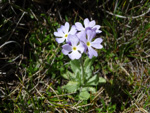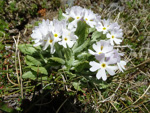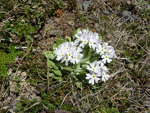Primula comberi W.W.Sm.
Section Aleuritia
Link to Flora of Argentina description
Type specimen: H.F. Comber 286 resides at E (specimen E00024778) and K (specimen K000364685) and P (specimen P04553722).
Primula magellanica subsp. comberi (W.W.Sm.) A.J.Richards.
Epithet: Named for the collector H.F. Comber.
Distribution: Chile and Argentina.
Primula comberi is related to P. magellanica and was considered a subspecies of it in 1993 by A.J. Richards. It is distinguished by the corolla tube which is twice the length of the calyx and the less capitate inflorescence of 3-6 (15) flowers. It is currently listed as a distinct species, most recently in the Flora of Argentina (Zuloaga, F.O. et al. 2021). P. comberi is up to 40cm tall, with elliptic to spathulate leaves, rounded or obtuse at the apex, cuneate to the short or almost obsolete petiole, crenate-dentate at the margin and densely farinose below. The scape exceeds the basal rosette and is farinose, especially near the apex. Bracts linear-lanceolate, gibbous and farinose. Pedicels farinose, 2-4mm and lengthening in fruit. Calyx farinose, tubular-campanulate and parted to the middle, lobes almost rounded at the apex. Flowers are annulate, more or less monomorphic, pale lilac, lobes obcordate and emarginate. It is distributed at high elevations (1500-2000m) along the Chile - Argentina border in the provinces of Chubut, Neuquén and Rio Negro in Argentina and Los Ríos Region in Chile. Overlaps in distribution with P. magellanica.







